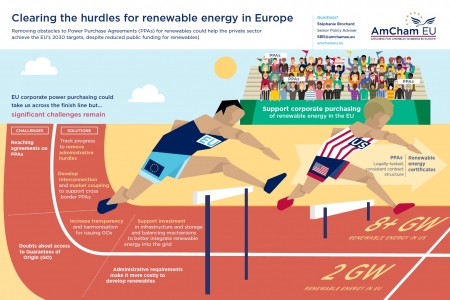You are here
Clearing the hurdles for renewable energy in Europe: the role of long-term contracts
Next week, the European Parliament’s ITRE committee is due to vote on the recast of the Renewable Energy Directive (RED).

As US companies investing in Europe, AmCham EU calls on MEPs to make long-term contracts, such as Power Purchase Agreements (PPAs), more easily accessible.
The Commission’s proposal on renewable energy seeks to change the business model for renewable energy projects, by phasing out feed-in-tariffs. A more market-driven energy market is welcome. However, to attract appropriate level of investment, renewable energy projects still require a high level of certainty on revenues. This is where PPAs will help achieve the EU’s climate and energy ambition despite decreasing public support.
PPAs can boost renewable electricity demand in the EU and help achieve the 2030 targets
PPAs have already proven very successful in the US: they have delivered substantial investment and innovation as well as deployment of advanced technologies. Over 8 gigawatts have come online in the US thanks to corporate purchasing of renewables, compared to only 2 in the EU. Therefore there is significant potential for long-term contracts and corporate actors to help deliver on the EU’s 2030 and 2050 targets.
Unleashing the potential of PPAs in the EU would not only benefit project developers and corporate consumers, but also Member States. By enabling corporate demand for renewable energy to thrive, PPAs would help Member States achieve their renewable energy targets by attracting investments.
The EU needs to seize this opportunity to support PPAs
However, many obstacles remain in the EU:
-Fragmentation of the EU energy market;
-Unclear or inconsistent crediting mechanisms for Guarantees of Origin (GOs) across Member States;
-Administrative hurdles, such as unreasonably long delays in permitting processes, which make it more costly to invest in renewables projects.
The EU has recently seen major PPAs concluded in Ireland, the Netherlands and Sweden, amounting to over one gigawatt. These deals confirm the potential of this business model. To accelerate this trend the EU should ensure that the Clean Energy Package:
Allows for tracking progress to remove administrative hurdles as part of the governance regulation;
-Supports the development of interconnection and market coupling to enable cross-border PPAs;
-Increases transparency and harmonisation for issuing GOs;
-Fosters investment in infrastructure and storage and balancing mechanisms to better integrate renewable energy into the grid.
The recast of the RED recognises that large scale renewable projects need to move beyond the feed-in-tariffs model that kick-started them. The timing is now perfect to position PPAs as essential tools to provide the long-term price signals which both renewable generators and energy users need to open up a new market, and bring a new set of consumers to renewable electricity.
Learn more on this topic and see our new infographic on PPAs here.
